Yoga for Desk Jockeys: 7 Tips To Save Your Back—At Work and On the Mat
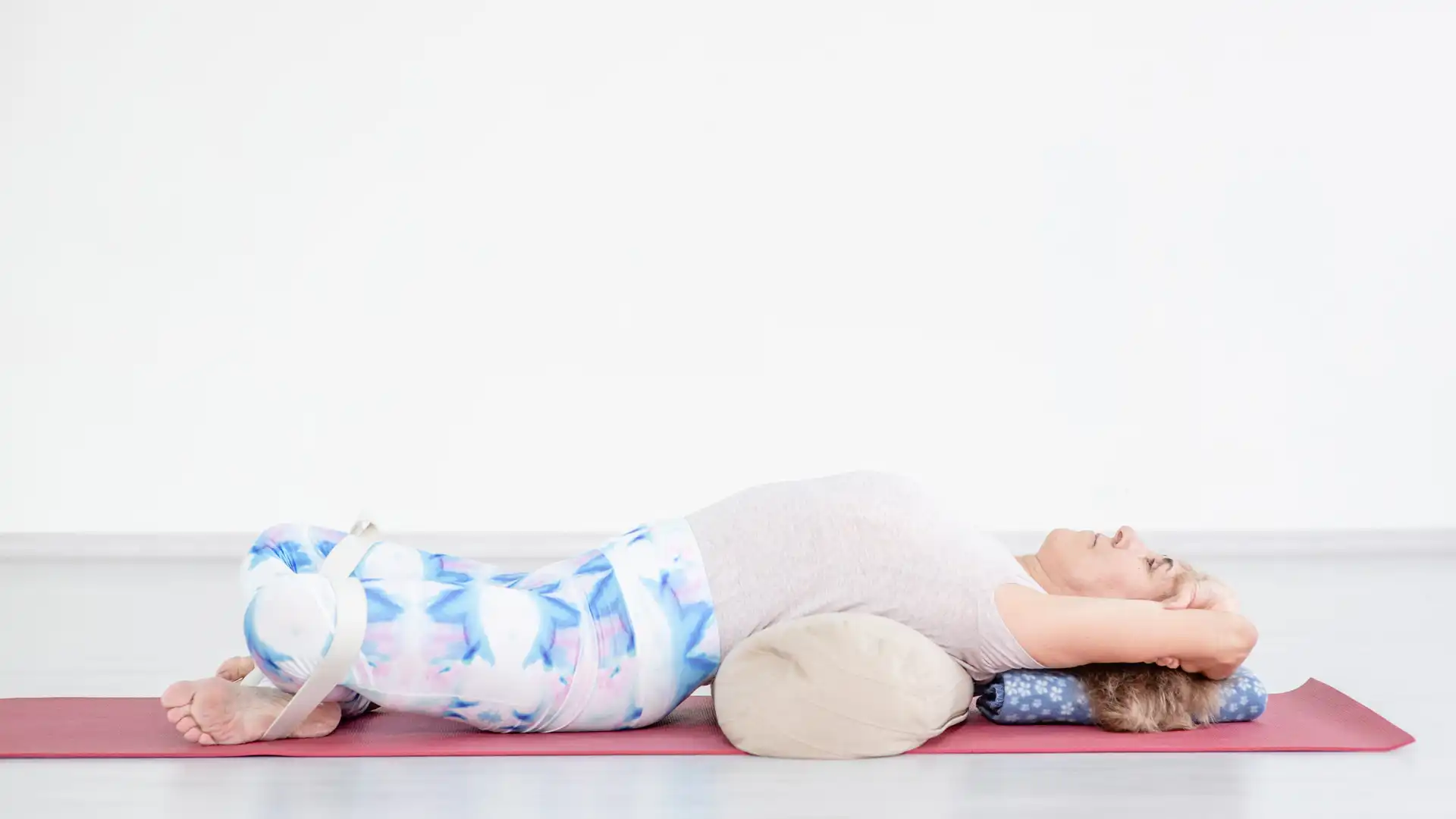
Back pain causes more missed days from work than any other medical reason, with the exception of the common cold.
Chronic back pain, with no known onset of injury, is often caused by muscular imbalances due to poor posture from a sedentary lifestyle. Those suffering from chronic pain also report higher rates of anxiety and depression, again leading to more missed workdays.
A July 2017 study published in the Annals of Internal Medicine (1) has confirmed what both previous research and yoga practitioners have long known: yoga works as well as physical therapy for lower back pain and can provide long-term relief.
Approximately 80 percent of Americans will at some point seek a doctor’s care for low back pain. In fact, low back pain is the leading cause of disability and costs more than $50 billion per year in over-the-counter and prescription pain relief.
The most recent study tracked 320 people with moderate to severe and persistent low back pain. Each was assigned to a 12-week yoga practice, 15 physical therapy sessions or back pain education.
Forty-eight percent of the yoga practitioners reported long-term relief, decreased pain and greater functional ability. The yoga group also had the most consistent participants. More people from the physical therapy and education groups dropped out of the study before completion.
Yet, the time off from work for back pain is often caused by or exacerbated by sedentary office jobs.
Here are Seven Tips to Keep Your Back Healthy and Strong at Work
1. Find the right seat. After just a few days at my new job, I wheeled my chair from office to office in search of a chair that was more ergonomically correct and a more appropriate height for me. The proper height of a desk chair is about 20 inches off the floor or a height that allows your feet to rest flat on the floor, with thighs horizontal to the hips and arms meeting the same height of the desk.
2. Adjust the computer keyboard and mouse to be within arms’ reach. Avoid having to reach, bend or twist to work on your computer. Even on day one of my new job, my neck was screaming at me. Apparently, I had been sitting with what I call a “turtle neck,” my head in a forward position. Rather than sitting straight and tall, the way I cue my yoga students, I found myself sitting with my ears in front of my shoulders causing pain in my neck as well as a rounding in my upper back.
at me. Apparently, I had been sitting with what I call a “turtle neck,” my head in a forward position. Rather than sitting straight and tall, the way I cue my yoga students, I found myself sitting with my ears in front of my shoulders causing pain in my neck as well as a rounding in my upper back.
To counteract the head-forward posture, throughout the day I practice pulling my chin back and lengthening my cervical spine. This relieves tension and reminds me to sit properly.
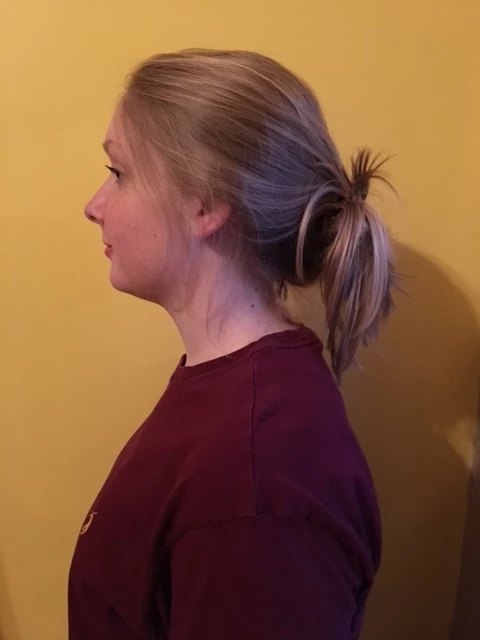
3. Avoid becoming a hunchback. It’s easy to forget spinal posture when spending so much time at a desk. Many of my yoga students appreciate chest openers and shoulder releases to relieve the tension of spending so much time hunched over. A quick work break for a simple chest expansion with a set of Gomukhasana (Cow Face Pose) Arms feels good on the upper back and shoulders and provides an opportunity for your eyes to look away from the computer. Here’s how:
-
Extend your right arm up toward the ceiling. Bend your elbow, bringing your right hand down your back.
-
Extend your left arm out in front of you at shoulder level. Circle your arm around behind you. Bend your left elbow and work your arm up your back, so that the back of your hand is between your shoulder blades.
-
Reach your right hand down your back and your left hand up your back to connect your fingers. If your fingers don’t touch, dangle a yoga strap downward from your right hand and grab the end with your left hand.
-
Breathe deeply allowing the chest and belly to fully expand. Repeat on the other side.
4. To relieve stress in the upper back, try Garudasana (Eagle Pose) Arms with a chin tilt. This pose is great for stretching your rhomboids and lower trapezius muscles:
-
From any comfortable seated position, extend your arms out in front of you at shoulder level.
-
Cross your right upper arm over your left upper arm.
-
Bend both elbows so that your forearms are vertical.
-
Rest the fingers of your left hand in the palm of your right hand.
-
Gently tilt your chin toward your chest to reach deeper into the scalene muscles, which run along both sides of the neck.
-
Stay for 5 to 10 breaths. Let your arms relax at your sides, then switch sides.
Also try a shoulder harness. I once had a yoga student who spent her workdays hunched over a microscope all day. For her extreme postural issues, I used a 10-foot yoga strap as a shoulder harness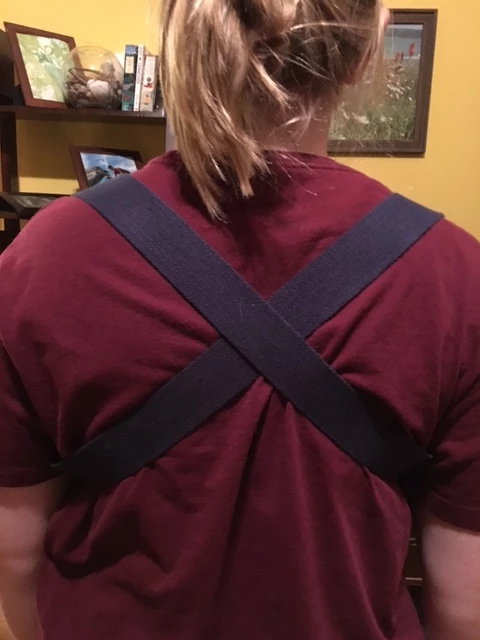 to correct the upper back rounding and misalignment.
to correct the upper back rounding and misalignment.
-
Begin by draping the strap from back to front over the right shoulder with the D-ring down.
-
Bring the strap in the back under the left shoulder, up and over the left shoulder and under the right shoulder, making an X in the back.
-
Loop the strap through the D-ring and tighten for comfort. You may need to adjust the X in the back for better placement just below the shoulder blades.
5. Use a headset. Cradling the phone between your shoulder and your neck is just asking for trouble. For conversations more than a minute or two, use a headset or speaker.
6. Breathe. The stress of rushing from one meeting to another or dealing with another workday interruption can lead to short, shallow breaths. Taking a bit of time to practice pranayama throughout the day will lower stress, improve posture and make you more productive.
-
Sitting tall, on an inhalation, breathe slowly and gently pull the lower abdominal muscles inward. Imagine you are trying to zip up a pair of tight jeans.
-
On the exhalation, activate the pelvic floor muscles as if you were trying to lift them up.
-
Repeat five times each throughout the day.
7. Get moving. Since I’m the new girl on the team, my office is all the way in the back. I have to get up and walk to the copier, the restroom and to my boss’s office. I really don’t mind being further away because it forces me to add in movement breaks in my day. Sometimes I’ll even take the longer route just to get in a few extra steps and allow my body more time moving and less time sitting.
Easy yoga poses to incorporate into your workday with minimal disruption include seated twists, neck stretches and Paschima Namaskarasana (Reverse Prayer Pose, also known as Penguin Pose).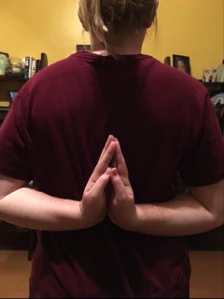
Reverse Prayer Pose loosens the shoulders, increases the flexibility in the upper back and opens the chest.
-
Sit tall in your chair with an elongated spine.
-
Breathing deeply, extend your arms behind you, palms together and fingers pointed to the ground.
-
Inhale and rotate the arms so that fingers are pointing toward your back, completing the rotation so fingers point upward.
-
As the fingers point up, the palms are together between the shoulder blades. If your palms don’t come together, bring the arms behind you and grab onto your opposite elbows.
-
Hold for 5 to 10 deep breaths.
Another of my favorite workday yoga breaks is what I call “Desk Down Dog”—Adho Mukha Svanasana (Downward-Facing Dog Pose) at your desk. I simply push my office chair back enough that my arms are stretched to reach my desk. Just as if I were holding onto a wall or my yoga mat, I push my hips back to create length in the spine. The benefit to doing this pose seated in the chair is I can gently swivel my hips side to side for an additional relaxing stretch.
After a Long Day, Try a Soothing Restorative Sequence
After long, stressful workdays, my evening yoga class members really appreciate a gentle flowing practice followed by longer holds in restorative poses.
Matsyasana with Support 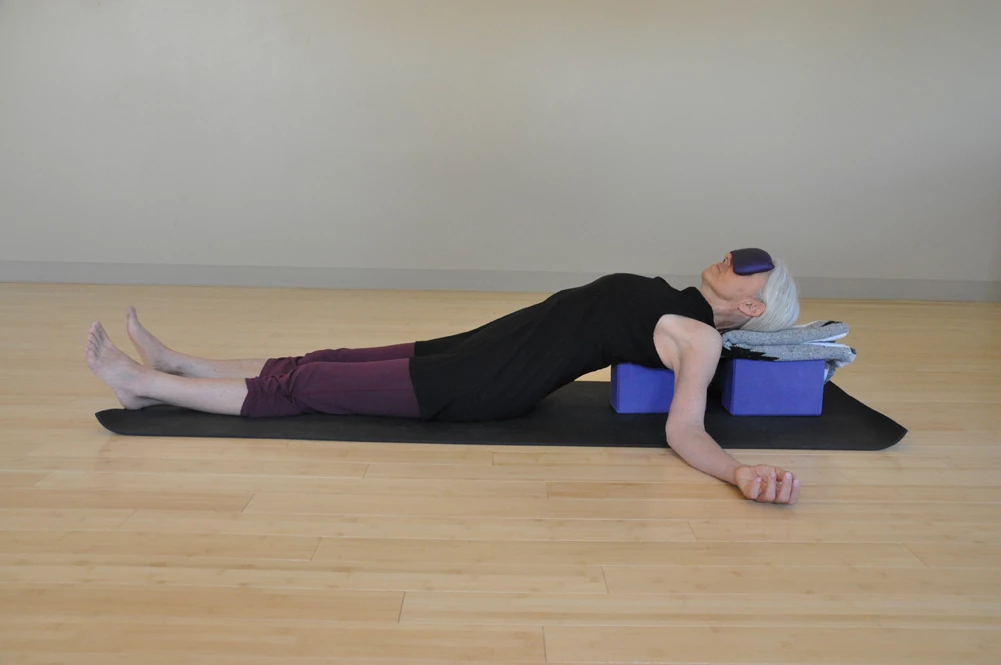
Fish Pose can relieve the symptoms of an achy back, anxiety, and fatigue. It is also an excellent pose to strengthen the muscles of the upper back and neck, therefore helping improve posture.
-
From a seated position with knees bent, place one block horizontally just under the shoulder blades. Place the second block under the head for support.
-
This restorative version of Fish Pose can take a little bit of adjusting to get the blocks into the best most relaxing position. Allow your arms to rest, palm up, along the sides of the body.
Supported Child’s Pose 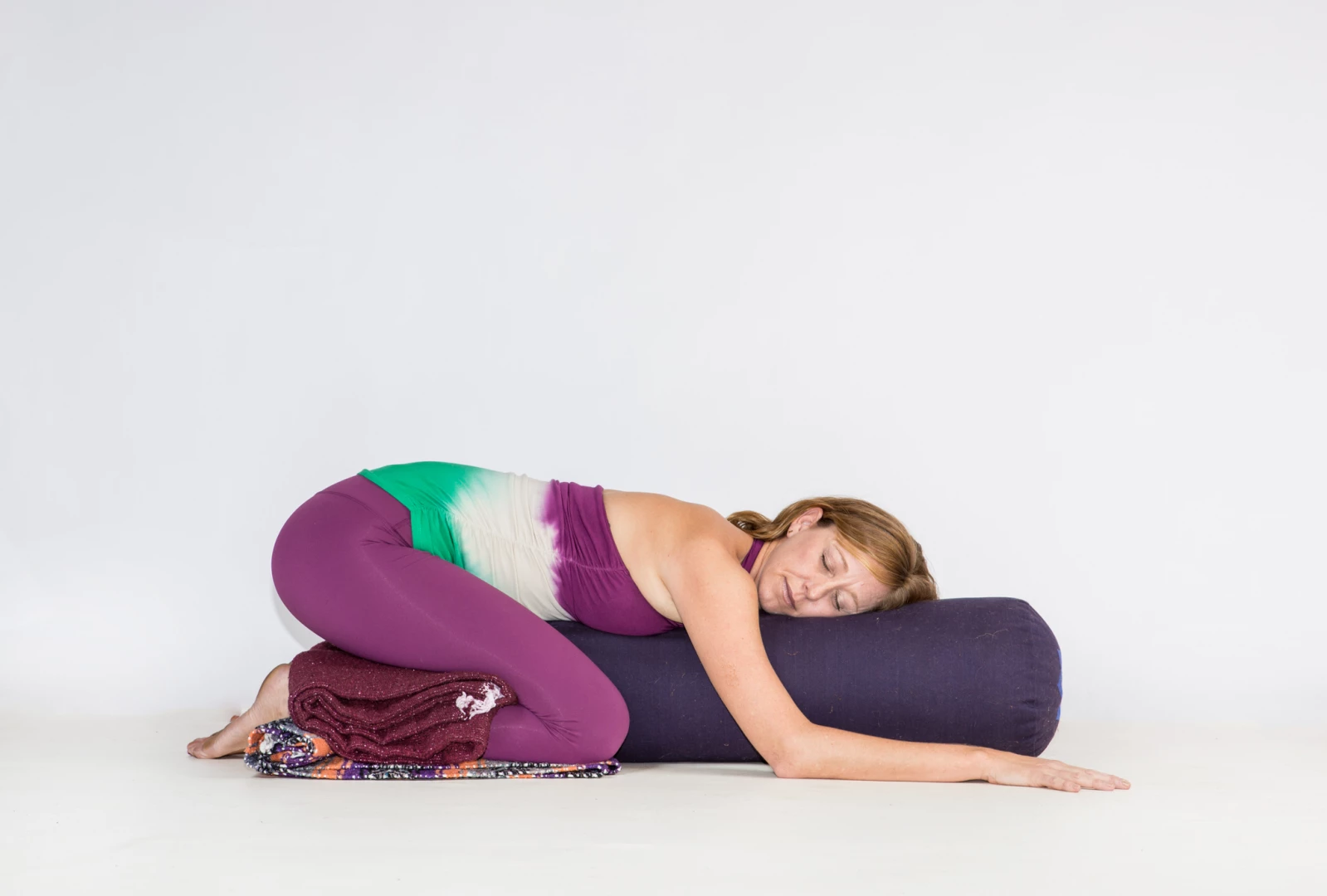
Supported child’s pose is a very calming pose to help relieve stress and anxiety. Using the support of the bolsters and blankets under the torso will relieve back and neck pain.
-
In Balasana (Child’s Pose), push your hips back toward your heels with knees as wide as possible in a V shape.
-
Pull a bolster, blankets or pillows close to your body, between your knees.
-
Drape your upper body over the bolsters, making any necessary adjustments to rest comfortably.
-
Stay here with your head resting to one side for about 10-20 breaths.
-
Repeat with your head resting toward the opposite side.
Viparita Karani (Clear Lake or Legs Up the Wall) with Neck Support 
Legs Up the Wall provides excellent relief for back pain and headaches. Follow these instructions for moving into Legs Up the Wall Pose, and then add a rolled-up towel, neck roll or blanket.
-
Place a rolled-up towel, neck roll or blanket under the neck for additional support. Filling the space between the cervical curve and the floor allows the muscles to relax and release.
-
Stay here for as long as you possibly can before being pulled back to reality.
Want more practice tips from YogaUOnline and writer Jennifer Williams-Fields? If so, read Teaching Yoga to Seniors: Ten Tips to Strike the Right Note.
More back care tips? Study with Eva Norlyk Smith and Terry Smith – Healthy Back, Healthy Body – Gentle Yoga for Stress Relief and Relaxation.
 Jennifer Williams-Fields E-RYT 200 is passionate about writing, yoga, traveling, public speaking and being a fabulous single momma to six super kids. Doing it all at one time, however, is her great struggle. She has been teaching yoga since 2005 and writing since she first picked up a crayon. Although her life is a sort of organized chaos, she loves every minute of the craziness and is grateful for all she’s learned along the way. Her first book “Creating A Joyful Life: The Lessons I Learned From Yoga and My Mom” is now available on Amazon. She has had her essays featured on Yahoo! and Dr. Oz The Good Life. She is a regular writer for Elephant Journal Magazine, Your Tango, and YogaUOnline. See more from Jennifer at jenniferwilliamsfields.com
Jennifer Williams-Fields E-RYT 200 is passionate about writing, yoga, traveling, public speaking and being a fabulous single momma to six super kids. Doing it all at one time, however, is her great struggle. She has been teaching yoga since 2005 and writing since she first picked up a crayon. Although her life is a sort of organized chaos, she loves every minute of the craziness and is grateful for all she’s learned along the way. Her first book “Creating A Joyful Life: The Lessons I Learned From Yoga and My Mom” is now available on Amazon. She has had her essays featured on Yahoo! and Dr. Oz The Good Life. She is a regular writer for Elephant Journal Magazine, Your Tango, and YogaUOnline. See more from Jennifer at jenniferwilliamsfields.com
Sources
1) http://annals.org/aim/article/2633222/yoga-physical-therapy-education-chronic-low-back-pain-randomized-noninferiority



